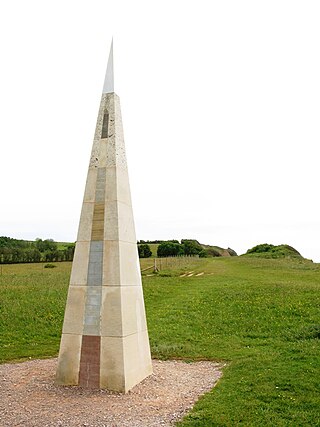
Orcombe Point is a coastal feature near Exmouth, Devon, on the south coast of England. It lies about 10 mi (16 km) south of the city of Exeter, 2 mi (3.2 km) southeast of Exmouth town centre and about 7.5 mi (12.1 km) southwest of Sidmouth.
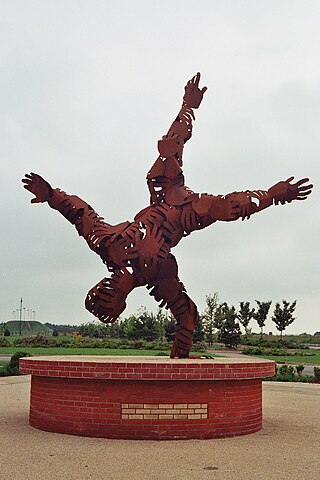
Martin Heron is a sculptor from Northern Ireland working with steel. He is a member of the Royal British Society of Sculptors and The London Group. His art is found outdoors in public places in Northern Ireland. His sculpture "For the Love of Emer" was Armagh City's first commission public artwork. It is a depiction of legendary Irish hero Cú Chulainn balancing on a 20-foot pole. His piece, Handstanding, is outside a public school in Ravenswood, Ipswich. Another sculpture group carved from tree trunks is found along the Irwell Sculpture Trail.
John Robinson was a British sculptor and co-founder of the Bradshaw Foundation. Accounts of his work may be seen at the Robinson estate website, the website of the Centre for the Popularisation of Mathematics and the June and July 2007, issues of Hyperseeing. Among other distinctions, he was the Official Sculptor for the British Olympic Committee in 1988, and a University of Wales Honorary Fellow, 1992.
Jon Edgar is a British sculptor of the Frink School. Improvisation is an important part of his reductive working process and developed from the additive working process of Alan Thornhill. Final works are often autobiographical, perhaps referencing anxieties or pre-occupations at the time. His body of work includes many clay portrait sketches of eminent sitters.
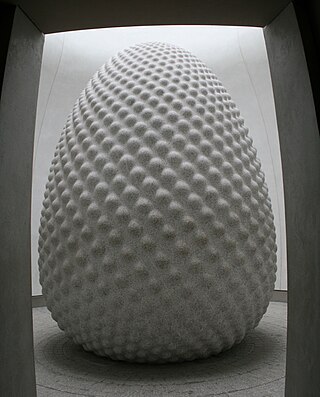
Peter Randall-Page RA is a British artist and sculptor, known for his stone sculpture work, inspired by geometric patterns from nature. In his words "geometry is the theme on which nature plays her infinite variations, fundamental mathematical principle become a kind of pattern book from which nature constructs the most complex and sophisticated structures".
Bruce Beasley is an American abstract expressionist sculptor born in Los Angeles and currently living and working in Oakland, California. He attended Dartmouth College from 1957–59, and the University of California, Berkeley from 1959-62 where he earned his BA.
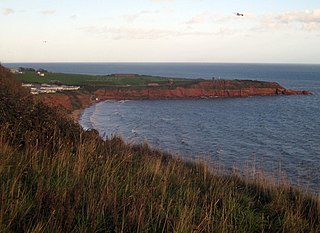
Sandy Bay is a secluded bay with a sand beach, about 1.6 kilometres (0.99 mi) long, in Exmouth, Devon, England. It is a sandy beach with rock pools at one end, backed by high cliffs. It is part of a long strip of sand which is connected to the beach at Exmouth at low tide. Nearby are the Orcombe rocks, which is a famous spot for fossils.
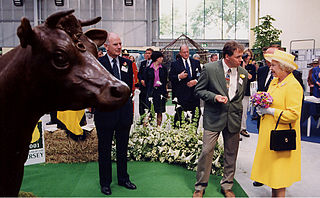
John McKenna is a Scottish sculptor born in Manchester. He is based in Turnberry, South Ayrshire, Scotland.

Edward Bowring Stephens, was a British sculptor from Devon. He was honorary secretary of the Institute of Sculptors circa 1861.
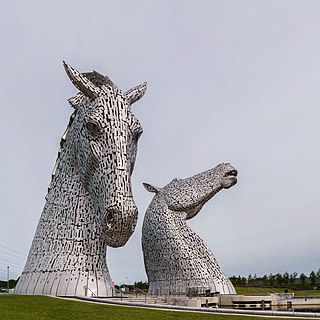
The Kelpies are a pair of monumental steel horse-heads between the Scottish towns of Falkirk and Grangemouth. They stand next to the M9 motorway and form the eastern gateway of the Forth and Clyde Canal, which meets the River Carron here. Each head is 30 metres (98 ft) high.
Terrance Kippax Plowright is an Australian artist, based in the Blue Mountains of New South Wales. His works include contemporary and figurative sculptures. He has designed and created large public sculptural water features and murals, substantial public cenotaphs, commemorative cast bronze sculptures, and a large body of religious and spiritual work that includes stained glass windows, altars, lecterns, baptismal fonts and mosaics.
Graham Bennett is a New Zealand sculptor.

Virginia King is a New Zealand sculptor. She sculpts in wood, metal and stone and is influenced by the natural environment and the forms of leaves, trees, shells, ferns and feathers. King's works can be seen in locations in New Zealand and Australia.
Denis O'Connor is an Irish sculptor and teacher, based in England since 1983. He has created many public sculptures by commission, which stand in locations in Britain and Ireland.
Robert Erskine FRSS is an English sculptor. He has created many public sculptures by commission, which stand in locations in Britain and Europe.
Hilary Cartmel is an English sculptor. She has created many public sculptures by commission, which stand in locations in Britain.
Tom Grimsey (1960–2014) was an English sculptor and teacher. He created many public sculptures by commission, which stand in locations in Britain.
Michael Dan Archer FRSS is a Scottish sculptor and teacher. His sculptures, some on a large scale, stand in many locations in Britain and abroad.
Judy Boyt FRSS is an English sculptor and ceramist. She has created on commission many sculptures, particularly of horses, which stand in locations in England.









